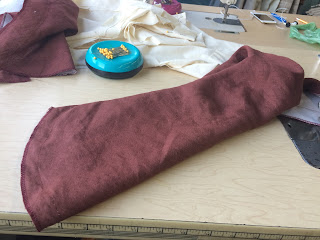It's been a busy winter and spring of costuming work, with lots of new challenges and new directions! With more employment opportunities (thank the Costume Gods!) and new situations, I have been keeping busy and haven't started a historical research project in some time. But what HAVE you been doing with your time, you say? I'll tell you.
In January I was honoured and delighted to take on a student, a 12 year-old sixth grader who loves historical costume and recently won a NYC-based grant to pursue a creative passion. With her prize money she bought a new sewing machine, began a research library, bought fabrics and hired a private tutor- moi. We worked over the course of 10 weeks to design, research, pattern and create a set of Elizabethan underpinnings, practicing important costuming techniques along the way. It was very interesting to find out which aspects of costuming do and no NOT come naturally to an adolescent: for instance, her vocabulary is more advanced than mine, but she would do things like lay newly-pressed fabric over a chair and sit on it. Interesting tactic! We worked on lots of overall sewing skills such as precise pinning, correct measuring, organizing a sewing space, pressing, and all the little details which most of us who have been sewing for years take for granted.
At the end of January also saw my first professional show as a designer, Shakespeare's "A Midsummer Night's Dream" presented in collaboration between the Shakespeare Theatre of New Jersey and the New Jersey Symphony Orchestra, directed by Bonnie Monte. Inspired by the concert-hall setting and full Mendelssohn score, the design was modern and formal with Greek and whimsical elements. I was working without a full staff, so the show was largely purchased or altered and no pieces were draped.
It wouldn't be my work without some flower crowns, naturally!
I got VERY excited about metallic spray-paint and created this masculine, laurel-inspired piece for Oberon
Titania's crown is gold and red with teardrop glass silver wire
Puck and Oberon- the theme for the fairies was formalwear with colorful, textured surface details. Oberon and Puck were in metallics, to visually separate them from the sillier fairies
Titania (Sarah Swift) and Oberon (Ben Stirling) backstage at NJ PAC
This piece was the real labour of love! Titania's gown is an off-the-rack number from 'David's Bridal' which we tailored to the actress's measurements, and then decorated with hand-placed trim, appliques and velvet flowers.
The fairies! (from left: Jon Sprik, Lindsey Kyler, Jesmille Darbouze and Jack Moran) Titania's attendant fairies were wearing ultra-modern, slim-fit tuxedos with whimsical, popping spots of color. Their movements were spazzy and comedic, and we went with an absurd, Mod look to go with it.
Hermia (Lindsey Kyler), Hippolyta (Sarah Swift) and Helena (Jesmille Darbouze) in their opening looks- modern formalwear with a draped, Grecian feel.
The mechanicals!!
These gents were so much fun to work with- our inspiration was "Orchestra Clowns," as though these men were asked to wear tuxedos but, being clueless and ridiculous, all fell somewhat short of the task in different ways. Peter Quince still wears his carpenter's toolbelt, Flute is missing his sleeves, and so on. Even Bottom, the most pretentious and serious of the group, couldn't find a pair of pants that were long enough.
The view from the stage at NJ PAC- what in incredibly inspiring (and daunting!) setting for my first show!
Designing "Midsummer" was an amazing, amazing experience- as a technician, I didn't expect that I would ever have (or even necessarily want) the opportunity to design a show. It was a whole different type of collaboration, working with the other designers (lights, set, etc) and directly with the director to creative a functional, cohesive vision which allowed for the restraints of quick-changes, portability, budget, and so on. I came away with a new appreciation for exactly how many distinct considerations and talents come together to create a show. It's the Magic of Theatre, and the experience was a beautiful reminder of exactly what I love about show-business.
There is one other big piece of news: in March I was accepted to the Masters program in Costume Technology at the University of North Carolina, Chapel Hill. After three glorious, painful, eye-opening and productive years in the professional world, I am finally heading back to school to buckle down and pursue my dream in a rigorous, academic setting. For three years I'll be taking classes in tailoring, mask-making, fabric dyeing, historical patterning, couture sewing techniques and so much more- I can't wait to get my ass kicked (academically speaking) and go through the "trial by fire" to emerge a classically trained, sleep-deprived and majorly well-educated Master of Fine Art!










 z
z























































